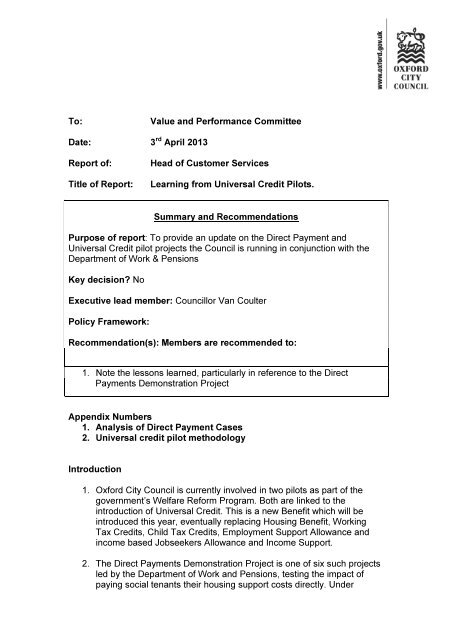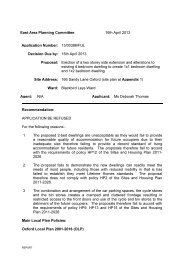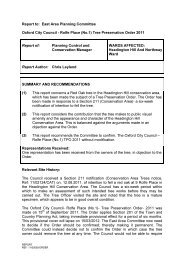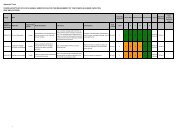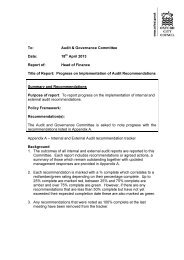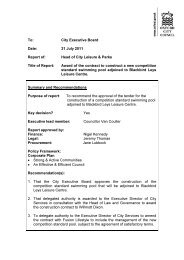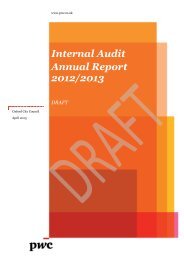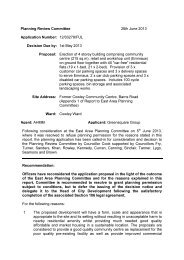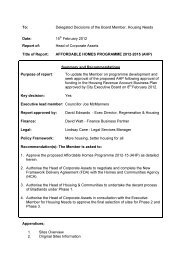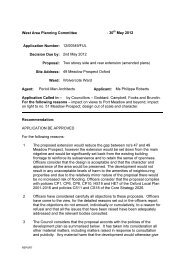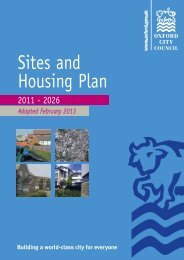Welfare Reform - Learning from Universal Credit Pilots PDF 182 KB
Welfare Reform - Learning from Universal Credit Pilots PDF 182 KB
Welfare Reform - Learning from Universal Credit Pilots PDF 182 KB
Create successful ePaper yourself
Turn your PDF publications into a flip-book with our unique Google optimized e-Paper software.
To:Value and Performance CommitteeDate: 3 rd April 2013Report of:Title of Report:Head of Customer Services<strong>Learning</strong> <strong>from</strong> <strong>Universal</strong> <strong>Credit</strong> <strong>Pilots</strong>.Summary and RecommendationsPurpose of report: To provide an update on the Direct Payment and<strong>Universal</strong> <strong>Credit</strong> pilot projects the Council is running in conjunction with theDepartment of Work & PensionsKey decision? NoExecutive lead member: Councillor Van CoulterPolicy Framework:Recommendation(s): Members are recommended to:1. Note the lessons learned, particularly in reference to the DirectPayments Demonstration ProjectAppendix Numbers1. Analysis of Direct Payment Cases2. <strong>Universal</strong> credit pilot methodologyIntroduction1. Oxford City Council is currently involved in two pilots as part of thegovernment’s <strong>Welfare</strong> <strong>Reform</strong> Program. Both are linked to theintroduction of <strong>Universal</strong> <strong>Credit</strong>. This is a new Benefit which will beintroduced this year, eventually replacing Housing Benefit, WorkingTax <strong>Credit</strong>s, Child Tax <strong>Credit</strong>s, Employment Support Allowance andincome based Jobseekers Allowance and Income Support.2. The Direct Payments Demonstration Project is one of six such projectsled by the Department of Work and Pensions, testing the impact ofpaying social tenants their housing support costs directly. Under
Housing Benefit regulations, nearly all social tenants have theirHousing Benefit paid straight to their landlord. <strong>Universal</strong> <strong>Credit</strong> will seea single payment made monthly to claimants, out of which they mustpay their rent to their landlord.3. The second project which began in December, focuses on how frontend services might be provided for <strong>Universal</strong> <strong>Credit</strong> and in particular,how we could support claimants into work. This pilot is in its earlystages, and the lessons learned so far are limited.Direct Payments Pilot – Payment Data4. The figures provided below represent the situation at 1 February 2013,after the seventh direct payment had been made. A more detailedanalysis of these figures is contained at Appendix 1.5. 1,371 Council tenants, out of 1,600 which were in scope of the project,have received a direct payment as part of this project. Of the remainingtenants which were in scope (119) have moved or stopped claimingHousing Benefit, (91) required some support before being able toreceive direct payment and (19) have not responded to us. Of thetenants who have received a payment, 294 have been switched backdue to excessive rent arrears accruing, and 33 tenants have moved orhave stopped claiming Housing Benefit. This leaves 1,044 cases still inreceipt of direct payment.6. Overall arrears for the project currently stands at 5.2% of all directpayments made. This compares against total arrears of 2.6% for allrent due. However if you exclude the cases that were added for thesixth payment in December, which had a particular set of problems(outlined below) this figure goes down to 4%.7. Encouragingly the trend for direct payment arrears is for them toreduce over time. For the 900 cases which were put in at the start ofthe project, the level of arrears is 3.4%. This suggests that tenants aregenerally able to manage direct payment, and the longer they receivedirect payments for, the better they manage their finances.8. As stated above there were a number of issues with the last phase oftenants entering the project, which skews the arrears figures. Theseincluded:• Tenants receiving their first direct payment in December, whichis a bad month for rent payment in any case due to the impact ofChristmas (there was a slight increase in arrears overall over theChristmas period).• Less information was known about tenant’s details (for 50 of the125 we did not know whether they held bank accounts).• Tenants were not written to advising them specifically that theywere about to receive their first direct payment, although they
had received a number of communications advising them thatthey were included in the project.This phase of entrants into direct payment was the last involvingsignificant numbers of tenants. The reason for this was because theacademic researchers requested that people receiving direct paymenthave at least six months involvement with the project. As this was thelast phase we also took the opportunity to test the impact of makingdirect payment to tenants in receipt of less support than had previouslybeen the case.9. Consequently, for this cohort arrears rose to 60.5% following their firstdirect payment. This reduced to 37.7% after the second payment.However 87 of the 125 tenants in this cohort have been switched back<strong>from</strong> direct payment. Whilst it is welcoming to see that even for thisgroup there was a huge improvement in payment relatively quickly, itclearly shows that understanding our customers and working with themis key to making direct payments successful.10. Of the 294 cases which have been switched back 54 have cleared theirarrears, and it is intended to revert some of these tenants back to directpayment of Housing Benefit, once we are sure they are in a position tomanage the change.Direct Payments Pilot – Lessons Learned11. All the project sites have discovered that they didn’t know theircustomers as well as they thought they did. For direct payments to besuccessful it is necessary to identify those customers who will needsupport with budgeting and setting up a bank account. This requiresgood customer knowledge. For new tenants this issue should bepicked up when they sign up for their tenancy. At this point we shouldbe establishing what type of bank accounts they hold, what debts theyhave and what their budgeting is like. There is then an opportunity toeither provide any necessary support, or refer them to an appropriateagency for help. For existing tenants we need to go and identify themourselves, and that can only be done by talking to them.12. It is essential to get the recovery process right. As part of the project,Rent Officers have been undertaking more recovery action via phonethan previously. This allows a more proactive, preventative approach tobe taken which can stop customers getting into further arrears andavoid the need to switch back. This is a significant culture change andone which has wider application across the Council.13. The Council’s preferred payment method is Direct Debit and theintention was for the project to maximise the use of Direct Debit forcollection. However tenant feedback shows that many people on lowincomes do not like Direct Debit, as a small error in budgeting can leadto bank charges. Consequently, the project will evaluate alternative
financial products to identify those most suited to assisting customerswith direct payment.14. A small proportion of tenants require significant support, and thatsupport can be quite intensive. A temporary support officer wasrecruited in December and given 30 cases where no bank account washeld by the tenant. So far, 15 of those cases now have an account andwill be moved into the direct payment project. However it can be verydifficult obtaining an appropriate account, especially where people donot have any photographic identification. Additionally we have foundthat some banks have been reluctant to open basic bank accounts.People without bank accounts will find it more difficult to make theirrent payments. Although they are likely to have a Post Office CardAccount where their <strong>Universal</strong> <strong>Credit</strong> could be paid into, it is notpossible to make payments out of this type of account.15. Not all tenants will need to pay their rent directly to their landlord under<strong>Universal</strong> <strong>Credit</strong>. One of the aims of this project is to inform the designprocess of <strong>Universal</strong> credit, particularly with regard to thecircumstances in which tenants would be exempt <strong>from</strong> Direct Payment.Once this is known it will be easier to plan future resource requirementfor this kind of support.Direct Payments Pilot – Challenges Ahead16. It is important to understand that the project allows the Council toclosely manage the process of paying housing benefit and collectingrent. In the <strong>Universal</strong> <strong>Credit</strong> environment the DWP will be responsiblefor making payment of the benefit. This creates a number ofchallenges.17. The DWP have said that there is unlikely to be any data sharingarrangements in place for social landlords. This means that unless thetenant tells us, we will not know when someone moves into <strong>Universal</strong><strong>Credit</strong>, when they will receive their payment of <strong>Universal</strong> <strong>Credit</strong>, andwhether payment has been suspended or ended. As such therelationship with the tenant becomes even more important. It will benecessary to be in regular contact with them to understand anychanges in their circumstances which will affect their <strong>Universal</strong> <strong>Credit</strong>claim.18. Payment of <strong>Universal</strong> <strong>Credit</strong> could be made on any day of the month.To allow customers to pay their rent as quickly as possible, we shouldallow Direct Debits to be collected on any day in the month.19. However successful tenants are in managing direct payments, therewill be an increase in the transaction costs of collecting rent, ascurrently one single transaction is made each week for all tenants inreceipt of Housing Benefit. There will also be an increase in the rangeof activity required to maximise rent collection, so a review of thecurrent structure of relevant teams is planned. Focus needs to be put
on preventative action and proactive customer engagement rather thanremedial recovery.<strong>Universal</strong> <strong>Credit</strong> Pilot20. This pilot is still in its early stages so there is little in the way of lessonslearned at this stage. We are focussing work on people impacted bythe Benefit cap, and the new Under-occupancy rules in the SocialSector (known as the Bedroom Tax). We have contacted 100 peopleso far to persuade them to work more closely with us and are nowconducting in depth triage interviews to find out what barriers to workthey have, and to plan how to begin addressing them. Appendix 2provides a more detailed description of the project methodology.21. Initially we are working with three providers who will support peoplefollowing their triage interviews. These are Jobcentre Plus, CAB andSkills UK. Jobcentre Plus can provide access to a variety of workrelated support. CAB can provide assistance with debt issues whichhad been identified as a significant barrier during our initial contact withpeople. Skills UK provide mentoring and coaching for people who havebeen out of work for some time, and can also assist with resolvingpractical issues, such as childcare provision. Throughout this processpeople will be supported by a keyworker working on the pilot in theCouncil. This approach also allows us to monitor and evaluate thesupport that is being provided, which will feed into the lessons learned<strong>from</strong> the pilot.22. Although its early days we have been surprised at the willingness ofpeople to work with us. Nearly everyone has reacted positively to theidea that they might need to get into work, although for many there area lot of hurdles to over come. We are generally finding that individualshave a myriad of issues which need to be tackled. Many of the peoplewe are talking to feel that the Work Programme has not provided themwith the help they feel they need, so this will be useful feedback for theDWP.23. As we are working with people impacted by the benefit changescoming in this year, one issue that keeps cropping up is that ofHousing, people impacted by the Bedroom Tax require assistance withalternative options. To support this area we are creating threeseconded posts to assist the work of the pilot. It is envisaged that staffcurrently in Housing will move into these roles. This will enable us todeal with more people impacted by the changes, and ensure we areable to address their Housing issues. More widely the Council needs toensure that the issues arising <strong>from</strong> the Bedroom Tax are taken intoaccount when considering allocations and planning policy. Placingsomeone in a property bigger than their needs could mean that the rentis unaffordable to someone who requires Housing Benefit.Financial Implications
24. Payment of <strong>Universal</strong> <strong>Credit</strong>, inclusive of housing support costs,directly to tenants present a significant financial risk to the Council. Thebest case scenario <strong>from</strong> our Direct Payment Project suggests anincrease in arrears <strong>from</strong> 2.6% to 4%. With a rent roll of approximately£37 million, this represents an annual increase in arrears of more than£500,000.24. Next year the Council has a Discretionary Housing Payment (DHP)grant of £525,000 to help support people affected by reductions in theirHousing Benefit. The Bedroom Tax and Benefit Cap are estimated tosee an annual reduction of £1,740,000 in Housing Benefit payments.This is in addition to reductions in Local Housing Allowance Rates thathave already been implemented resulting in a £1,500,000 reduction inHousing Benefit payments. The Council is permitted to top up its grantby one and a half times the amount <strong>from</strong> the government, which wouldbe £787,500. However it is not sustainable for the Council to providethis level of support on an ongoing basis. In preparation for theincrease in DHP applications, the Council’s DHP policy has beenredrafted, and will be submitted to CEB for approval. It is currently withstakeholders for comments. To make best use of DHP funding, thenew policy puts greater onus on recipients to take steps to reduce theirreliance on DHP, and makes provision for any future awards to be asmaller amount.25. Where families are evicted <strong>from</strong> their properties and placed intemporary accommodation, there is a cost to the Council in HousingBenefit Subsidy. Currently the number of families housed in this way isvery low. There have only been 37 cases this year, which have cost£22,000 in lost subsidy. A significant rise in the number of familieshoused in this way would see a proportional rise in these costs.Legal Implications24. NoneName and contact details of author:-Name Paul WildingJob title Benefit ManagerService Area Customer ServicesTel: 01865 252461 e-mail: pwilding@oxford.gov.ukList of background papers: None
Version number: 1.0
Appendix OneDirect Payments - Seventh Period AnalysisAnalysis was carried out in week 32 (financial week 44) so 4 weeks rent hasbeen excluded <strong>from</strong> analysis.• 1371 out of original 1600 were added in phase 1, 2, 3, 4 & 6: -To date, (01.02.13) the 1371 are broken down as follows:33 Tenancies have ended294 Have had their HB payments reverted back to OCC (Switch Back)902 Live accounts are in credit or have a nil balance84 Live accounts have reduced their arrears since joining the scheme0 Live accounts have a static debt on their account58 Live accounts have increased arrears since joining the schemeOf the 33 tenancies that have ended12 In credit or nil balance3 Reduced arrears18 Increased arrears since joining the schemeOf the 294 Account that have been Switched Back8 Tenancies have ended (3 are in credit/nil & 5 have increased arrears)54 Nil balance or in credit16 Reduced arrears <strong>from</strong> when joining the scheme216 Increased arrears <strong>from</strong> when joining the schemeNB: Those accounts with a nil balance are being prepped to go back ontodirect payments hopefully in the next payment period.Arrears analysis has been carried out on the 297 accounts with increasedarrears.NB: Some of these accounts had arrears when they joined the scheme,analysis has been carried out on the RISE in arrears so previous arrears havebeen disregarded.Increasing Arrears (Live Cases, Switch Backs & Closed Accounts wherearrears have increased)Weeks Rent Equivalent OwedRisk ScoreLess than 4wks rent 56 Risk No. % ValueAverageExactly 4wks arrears 7 0 195 66% £90,710£465Between 4-8wks arrears 113 1-3 86 29% £41,333£481Exactly 8wks arrears 4 4+ 16 5% £9,118£570
Over 8wks 117 297 £141,161£475297% of Rent Covered by HB Age Range% HB No. % Value Average Age No % ValueAverage01-24 2 1% £305 £152 18-24 16 5% £8,638£54025-49 13 4% £4,833 £372 25-35 77 26% £36,210£47050-74 26 9% £7,177 £276 35-44 75 25% £38,875£51875-99 50 17% £23,534 £471 45-54 101 34% £46,027£456100 206 69% £105,312 £511 55-59 28 10% £11,411£408297 £141,161 £475 297 £141,161£475The debt as a % of rent charged is reducing as can be seen below:Rising ArrearsGross rentchargedDebt as % of rentcharged1st period analysis £35,251 £342,238 10.30%2nd period analysis £80,579 £743,473 10.84%3rd period analysis £82,190 £1,193,484 6.89%4th period analysis £97,843 £1,670,876 5.86%5th period analysis £102,732 £2,132,897 4.82%6th period analysis £105,889 £2,184,187 *4.84%7th period analysis £141,161 £2,713,666 5.2%* New cases were added to Phase 6 which has seen slight increase inarrears, as seen in Phase 1.The split between the phases is:Phase 1 Phase 2 Phase 3 Phase 4 Phase 6 TotalNo. of weeks live 28 24 20 16 8Total rent charged £2,067,000 £264,896 £205,574 £80,099 £96,097 £2,713,666Rising Arrears - £ £69,606 £13,471 £11,458 £10,372 £36,254 £141,161Debt as % of rentcharged 3.36% 5.08% 5.57% 12.94% 37.72% 5.2%Below shows the arrears for each phase at each payment period.These demonstrate that the longer that claimants receive their HousingBenefit direct, the more responsible the claimant becomes in paying their rent.Phase 1 onlyRisingArrearsGross rentchargedDebt as % ofrent charged1st period analysis £35,251 £342,238 10.30%2nd period analysis £66,831 £684,476 9.76%3rd period analysis £53,667 £1,026,713 5.23%4th period analysis £64,021 £1,368,944 4.7%
5 th period analysis £61,938 £1,713,195 3.6%6th period analysis £66,990 £1,682,292 3.98%7th period analysis £69,606 £2,067,000 3.36%Phase 2 onlyRisingArrearsGross rentchargedDebt as % ofrent charged1st period analysis n/a n/a2nd period analysis £13,748 £58,997 23.30%3rd period analysis £16,596 £117,995 14.07%4th period analysis £15,145 £176,988 8.6%5 th period analysis £14,365 £220,514 6.5%6th period analysis £13,293 £224,812 5.91%7th period analysis £13,471 £264,896 5.08%Phase 3 onlyRisingArrearsGross rentchargedDebt as % ofrent charged1 st & 2 nd period analysis n/a n/a3rd period analysis £11,927 £48,776 24.45%4th period analysis £12,206 £97,552 12.5%5 th period analysis £14,515 £143,405 10.1%6th period analysis £13,167 £165,871 7.93%7th period analysis £11,458 £205,574 5.57%Phase 4 onlyRisingArrearsGross rentchargedDebt as % ofrent charged1 st 2 nd & 3 rd period analysis n/a n/a4th period analysis £6,471 £27,392 23.6%5 th period analysis £11,914 £55,783 21.4%6th period analysis £12,034 £62,361 19.29%7th period analysis £10,372 £80,099 12.94%Phase 6 onlyRisingArrearsGross rentchargedDebt as % ofrent charged1 st 2 nd & 3 rd period analysis n/a n/a6th period analysis £29,536 £48,851 60.46%7th period analysis £36,254 £96,097 37.72%
Appendix Two<strong>Universal</strong> <strong>Credit</strong> Pilot MethodologyLA Led PilotIntroductionThe <strong>Welfare</strong> <strong>Reform</strong> agenda means tenants within Oxford City are likely to facesignificant reductions in their household income, particularly customers subject to theUnder-Occupancy restrictions and the Benefit Cap. This Pilot aims to work withcustomers affected by the <strong>Welfare</strong> <strong>Reform</strong>s to identify barriers that preventcustomers entering work and the solutions for removing those barriers. The learning<strong>from</strong> this Pilot will be used to inform the Department for Work and Pensions (DWP)policy division and the implementation of <strong>Universal</strong> <strong>Credit</strong>.ObjectivesThe overarching objectives for the Pilot are as follows:• Identifying the barriers that prevent customers <strong>from</strong> entering work• Identify the options and solutions for assisting customers including theidentification of Partners with the skills to assist• Capture and record the learning through customer engagementMethodologyThe approach of the Pilot is to provide a resource intensive solution to supportingcustomers through the <strong>Welfare</strong> <strong>Reform</strong>s. We have appointed a Pilot Lead and a<strong>Welfare</strong> <strong>Reform</strong> Outreach Worker who will engage with customers. This holisticapproach will ensure customers have constant support available and not just supportfocussed on specific areas/barriers.The Pilot will follow the following model:Research => Test => Refine => Deliver => ReviewResearchA lot of research work relating to the barriers that prevent people entering work hasbeen undertaken in recent years so we have used this learning to inform our Pilot inits early stages. Organisations whose research has been used include: Gingerbread,Iseekjobs, DWP Policy and Research division, CAB & independent websitesincluding those with forums where customers have posted personal experiences ofbarriers to work.As a result, some common barriers identified include:• Lack of child care• Health issues preventing work• Fear of the instability of entering work• Lack of skills• DebtWe have conducted a brief review of the mainstream organisations in the District whoprovide the services associated with removing the barriers to work. We have alsotaken into account their restrictions for clients wanting to access their services i.e.geographical location etc.TestTo ensure the basis for our Pilot is robust and our local needs are matched to theresearch, we have tested our findings with a selection of customers during someproactive contact calling to customers affected by either the Under-Occupancy
estrictions or the Benefit Cap. This customer feedback has confirmed that most ofthe recognised barriers to work are common amongst our customers and that mostcustomers have multiple barriers. In addition to this we confirmed that peoplegenerally seem very keen on engaging with the Local Authority in removing thesebarriers.RefineThe tested enabled us to make some informed decisions relating to the Pilot. Wehave focussed on overcoming the more common barriers i.e. lack of employmentskills and have left some of the more niche area’s i.e. drug or alcohol abuse until thePilot when processes will be better established. Until this time we will use existingsignposting mechanisms already in place where we encounter these issues.The testing also enables us to better identify the agencies we could work with thatwould effectively support customers. To ensure we can capture the learning andensure the Pilot can be managed effectively in its early stages we identified 3agencies <strong>from</strong> our review of the organisations available in the District to work withinitially. The considerations included: capacity of the organisation to undertake thework, capacity of the organisation to provide adequate feedback and attend thesteering group meetings, whether additional funding would be required and whatfunding the LA was already providing (where appropriate), the capacity to help thePilot ensure its aims are achieved.The organisations selected for the initial work are:Skills UK – Have the capacity to take referrals and to provide an on site presence atSt Aldates one afternoon per week. They have very few restrictions for customers toaccess their services although importantly they cannot work with customers alreadyengaged with the work programme. They can cover all areas in the District and offera visiting service where appropriate. They provide a similar caseworker styleapproach as the Pilot aims to do and have skills relating to a number of the majorbarriers to work.Job Centre Plus – For customers already engaged with the Work Programme andalready in contact with the Job Centre. They have a history of supporting customersinto work.CAB – we recognise that not everyone affected by <strong>Welfare</strong> <strong>Reform</strong>s will be able toenter work and as a result will need to find alternative ways to cope with the incomereduction. The CAB will provide Financial Capability or debt advice where customersindicate this would assist during their interview. We have selected the CAB as theyhave no restrictions as to who can access their services or limitations relating to thearea in which a person lives. Customers referred by the Pilot will not receive anypreferential treatment with regard to accessing the services but the CAB will providefeedback to the Pilot regarding the advice given. In addition, the LA already fundssome debt advice services within the CAB and this can be seen as an extension ofthis service.No funding (or additional funding) has been provided to the partners identified abovefor the work undertaken as part of the Pilot.DeliveryDelivery of the Pilot involves a triage process for customers who are identified oractively seek additional support as these <strong>Welfare</strong> <strong>Reform</strong>s take effect. Thesereferrals mainly result <strong>from</strong> conversations with the Contact Centre who have beenbriefed on what factors might warrant a referral or other staff within the LA whoidentify a need through contact with a customer affected.
Once identified, referrals are made to the Pilot who pro-actively contacts thecustomer to discuss their needs and their options in more detail. This initial call alsoincludes a data check section where the customer’s circumstances are reviewed foraccuracy whilst potential exemptions <strong>from</strong> the <strong>Welfare</strong> <strong>Reform</strong> restrictions areinvestigated.In most cases, where it is established that the <strong>Welfare</strong> <strong>Reform</strong>s will impact thecustomer, an interview is arranged with the aim of trying to fully understand thecustomers needs, the barriers preventing them entering work and the solutions forremoving those barriers. An action plan is agreed with the customer and wherefurther needs are identified that require 3 rd party involvement a warm hand off isarranged which includes a full briefing to the 3 rd party.Follow up interviews/calls are made after the 3 rd party’s actions to establish thecustomers opinion regarding the outcomes of the meetings and to determine whatadditional actions are required to move forward.As a result of customer feedback, we also plan to add additional resources with afocus on housing to the Pilot as housing concerns are proving a major barrier tocustomers accessing work.ReviewWe are required to provide bi-monthly evaluations to the DWP as part of the pilot andplan to review the existing process and partnership arrangements at the end of April2013 with the view to checking the <strong>Pilots</strong> effectiveness and also to review the scopeof the pilot. An ongoing review of the processes in place will naturally occur andincrease the efficiency and effectiveness of the Pilot as we progress.In addition, we aim to review the resource arrangements for the Pilot based on theneeds of the customer.Governance arrangementsPlease see annexe A as a proposed structure for the Governance arrangements forthe Pilot.Metrics / measure of successAs numbers engaging with the Pilot are unpredictable we plan to use qualitativemeasures as well and quantative measures to determine success.Measures will include:• The number of people who actively engage with the Pilot in comparison to thenumber of customers affected by the <strong>Welfare</strong> <strong>Reform</strong>s• Customers supported into Education, training or work• Changes in customer attitudes towards accessing work• Customer attitude towards engaging with the LA and its partners• Number of positive outcomes for customersFurther details relating to the measures including the methodology for calculation andsupporting data collection to substantiate the measures are part of the support Pilotdocumentation.
Objectives for Project Boards:Keep project on trackManagement information toDWP<strong>Learning</strong> to DWPObjectives for <strong>Welfare</strong> <strong>Reform</strong>Officer Group:Project assuranceProject delivery overviewRemoving barriers to deliveryReceipt of Early learning &DWP updates and formulation oforganisational designRecommendations to CustomerFirstObjectives for Customer FirstBoard:Project highlight reportsRatification of early learning andorganisation design principlesRecommendations to <strong>Welfare</strong>Reference Member GroupObjectives for <strong>Welfare</strong>Reference Group:DWP and <strong>Welfare</strong> reformgeneral updatesProject updatesConsultation on organisationdesignFeedback to officer groupCustomer First Programme Board(Monthly)Attendees: Helen Bishop (Chair), Jane Lubbock, Peter Sloman, JackieYates, Peter McQuitty, Emma Burson, Abby Abrahams, Karen Ravenhill,Gary Thomas


